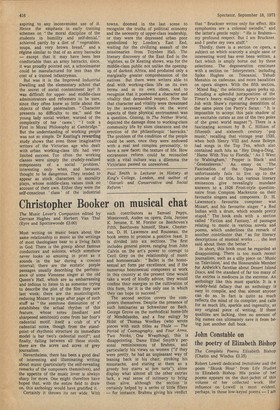So do I.
Victorian workers
was concentrated not on putting workingclass homes up but on knocking the more insanitary of them down. While health measures, railway building, and urban ' improvements ' reduced the stock of housing, no adequate steps were taken to provide cheap accommodation for those displaced, and existing overcrowding was intensified. When philanthropic bodies and local authorities began to try to alleviate the situation in the large towns in the second half of the century, rising population, land values, and building costs made it impossible for them to achieve rapid progress.
The difficulty of improving working-class dwellings only increased the need to condition working-class minds. Dr Hurt's excellent study — a contribution to administrative as well as educational history — centres on the origins and work of the Education Department from 1839 to 1870, and stresses how the state-aided voluntary system of popular education which preceded Forster's Act saw its task as the preparation of working-class children for the efficient and deferential discharge of the duties of their station. He shows how the state's efforts in this period went largely to support the role of an Anglican establishment seeking through its schools to sustain the social influence which it was failing to strengthen, at least in the towns, through its churches. The latent tension between the purposes of church and state (it is odd here that Dr Hurt omits to discuss the vexed conscience clause issue) was underlined when Lowe's Revised Code of 1861, in its anxiety to secure efficient secular instruction, thrust religion into an increasingly subordinate position. Dr Hurt puts up a shrewd, if not fully convincing, defence of the Revised Code, but he is perhaps most interesting on a neglected subject, the training of the teachers. They posed a special problem: they had both to be given an education that raised them above their class and at the same time to be discouraged from aspiring to any inconvenient use of it. Hence the emphasis in early training schemes on "the moral discipline of the students in humility and self-denial," achieved partly by a diet of "vegetables, soups, and very brown bread," and a regime similar to that of an army barracks — except that it may have been less comfortable than an army barracks, since, it was proudly pointed out, a schoolmaster could be manufactured for less than the cost of a trained infantryman.
But was it in the Improved Industrial Dwelling and the elementary school that the secret of social contentment lay? It was difficult for upperand middle-class administrators and reformers to be sure, since they often knew so little about the objects of their paternalism. " Character presents no difficulty to me," said the young lady social worker, warned of the complexity of her ' cases '; "I took a First in Moral Philosophy at Cambridge." But the understanding of working people was not so simple. Dr Keating's rewarding study shows that even those imaginative writers of the Victorian age who dealt with urban working-class life had very limited success. Too often the working classes were simply the crudely-realized components of a social 'problem,' interesting only when, and because, thought to be dangerous. They tended to appear as stock characters in morality plays, whose middle-class values took no account of their own. Either they were the self-conscious ' class ' of the industrial towns, doomed in the last scene to recognize the truths of political economy and the necessity of upper-class leadership, or they were the depressed urban poor symbolized by London's East End, waiting for the civilizing assault of the missionaries from Toynbee Hall. The literary discovery of the East End in the 'eighties, as Dr Keating shows, was for the middle-class public not unlike the openingup of darkest Africa, and produced only a marginally greater comprehension of the natives. But there were writers able to deal with working-class life on its own terms and in its own idiom, and to recognize that it possessed a character and vitality that demanded respect. How far that character and vitality were threatened by the necessary attack on the worst aspects of their physical environment was a question. Gissing, in The Nether World, depicted the damage done to working-class community life by slum clearance and the erection of the philanthropic 'barracks.' The problem of the condition of the people could be seen, once they were endowed with a real and complex personality, to have a new facet: the texture of life. How extraneous reform could be reconciled with a vital culture was a dilemma the Victorians passed on unresolved.
Paul Smith is Lecturer in History at King's College, London, and author of 'Disraeli and Conservative and Social Reform'



































 Previous page
Previous page